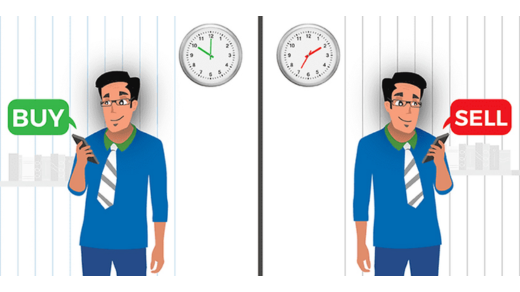Key Difference in Time Horizon
Intraday trading and delivery trading are distinguishable by their respective time horizons in the stock market. Intraday trading involves buying and selling securities within the same trading day, aiming to capitalize on short-term price fluctuations. This approach demands quick decision-making and sharp market analysis to profit from rapid market movements.
On the other hand, delivery trading focuses on a longer time horizon, wherein investors hold securities for days, weeks, or even years. This trading strategy often involves a more thorough analysis of company fundamentals and market trends to make informed investment decisions. By understanding this fundamental difference in time horizon, traders can tailor their strategies to match their financial goals and risk tolerance.
Research Recommendation Intraday trading and delivery trading differ in time horizons. Intraday trading involves buying and selling securities within the same day, aiming for short-term gains. Delivery trading focuses on longer-term investments, requiring thorough analysis of company fundamentals and market trends. Tailoring strategies based on this time horizon is crucial for achieving financial goals.
Key Difference in Trading Strategy
When it comes to trading strategy, one of the main differences between intraday and delivery trading lies in the timeframe in which trades are executed. In intraday trading, traders buy and sell securities within the same trading day, aiming to profit from short-term price movements. This requires a quick decision-making process and the ability to react swiftly to market fluctuations.
On the other hand, delivery trading involves holding onto securities for a longer period, typically days, weeks, or even months. Traders who opt for delivery trading are looking to capitalize on the long-term growth potential of a stock or an asset. This strategy requires a more patient approach and a thorough analysis of the fundamentals of the securities being traded.
Impact on Risk Management
Intraday trading and delivery trading present distinct challenges when it comes to managing risks. Intraday traders face heightened risk due to the short time frames involved in their trades. The fast-paced nature of intraday trading requires quick decision-making and can lead to increased volatility and potential losses. As a result, meticulous risk management strategies are essential for intraday traders to protect their capital and navigate the inherent uncertainties of the market.
On the other hand, delivery trading involves holding positions for a more extended period, typically ranging from a few days to several months. While this longer time horizon may seem less risky compared to intraday trading, it comes with its own set of challenges. Delivery traders need to consider factors such as market trends, company fundamentals, and broader economic conditions that can influence the performance of their investments over time. Effective risk management in delivery trading involves diversifying portfolios, setting stop-loss orders, and staying informed about market developments to mitigate potential risks and maximize returns.
Role of Leverage in Intraday vs Delivery Trading
Intraday trading and delivery trading differ significantly in terms of the role leverage plays in each strategy. In intraday trading, leverage is commonly used to amplify the potential gains from small price movements within a single trading day. Traders can use borrowed funds to increase their position sizes and potentially generate higher returns, but this also comes with increased risk due to the short time horizon and volatility inherent in intraday trading.
On the other hand, delivery trading typically involves taking a longer-term view on stock investments, with traders buying and holding securities for an extended period. Leverage is generally less common in delivery trading as the focus is on the fundamental value of the stocks rather than short-term price fluctuations. By reducing reliance on leverage, delivery traders aim to minimize the impact of market volatility and fluctuations on their portfolio, focusing instead on long-term growth potential and income generation.
ETF Recommendation In intraday trading, leverage is used to amplify gains from small price movements within a day. In contrast, delivery trading focuses on long-term stock investments, with less reliance on leverage to minimize market volatility impact and prioritize long-term growth potential and income generation.
Key Considerations for Intraday Traders
When engaging in intraday trading, one must carefully consider market volatility and liquidity. Due to the short timeframe involved, prices can fluctuate rapidly, making it crucial for traders to stay attentive and react quickly to market movements. Additionally, the high liquidity in intraday trading can be both an advantage and a challenge, as it provides ample trading opportunities but also increases the risk of sudden price changes.
Risk management is another key consideration for intraday traders. Setting stop-loss orders and adhering to risk management principles are essential to protect capital in this fast-paced trading environment. It is vital for traders to establish clear risk-reward ratios for each trade and avoid overleveraging to prevent significant losses. By developing a disciplined approach to risk management, intraday traders can enhance their chances of long-term success in the markets.
Key Considerations for Delivery Traders
In delivery trading, one of the key considerations for traders is the importance of conducting thorough research and analysis before making any investment decisions. Unlike intraday trading, where positions are held for a very short duration, delivery trading involves holding onto securities for a longer period. This means that traders need to carefully evaluate the fundamentals of the stock, market trends, and any other relevant factors that could impact the value of their investments over time.
Another critical factor for delivery traders to consider is the potential impact of external events and market volatility on their investments. Since delivery trading involves holding positions for days, weeks, or even months, traders are more exposed to market fluctuations and external factors that can influence stock prices. It is essential for delivery traders to stay informed about economic indicators, corporate developments, and geopolitical events that could affect the performance of their investments in the long run. Being proactive in monitoring market trends and staying abreast of relevant news can help delivery traders make informed decisions and manage their portfolios effectively.
Tax Implications for Intraday Trading
When it comes to tax implications for intraday trading, it is essential for traders to be aware of the specific regulations governing this aspect of their trading activities. Intraday trading involves buying and selling securities within the same trading day, which can lead to different tax treatment compared to delivery-based trading. The gains or losses from intraday trading are typically considered as a business income or loss, subject to income tax as per the individual’s tax slab.
Further, intraday trading does not enjoy the benefit of long-term capital gains tax treatment, as the holding period for intraday trades is significantly shorter. Traders engaged in intraday trading are required to maintain detailed records of all transactions, including profits and losses, to accurately calculate their tax liabilities. It is advisable for intraday traders to consult with a tax professional to understand the specific tax implications based on their trading activities and individual circumstances.
What is intraday trading involves buying and selling securities within the same trading day, leading to different tax treatment compared to delivery-based trading. Gains or losses from intraday trading are considered as business income subject to income tax based on the individual’s tax slab.
Tax Implications for Delivery Trading
One of the significant aspects that traders engaged in delivery trading need to consider is the tax implications associated with their transactions. The tax treatment for delivery trading involves taxes on capital gains, which are calculated based on the profits earned from the sale of securities held for more than a stipulated period, usually one year. Long-term capital gains tax rates are generally lower compared to short-term capital gains, providing an incentive for investors to hold onto their investments for a longer duration.
Additionally, delivery trading also entails the possibility of claiming tax benefits on losses incurred during the trading period. These losses can be set off against any capital gains made during the same financial year, helping traders reduce their overall tax liability. Understanding the tax implications of delivery trading is crucial for traders to effectively manage their tax obligations and optimize their overall investment returns.
Key Factors Influencing Profitability in Intraday Trading
Intraday trading is characterized by its fast-paced nature, where traders aim to capitalize on small price movements within a single trading day. One key factor influencing profitability in intraday trading is the ability to accurately analyze and interpret market data in real-time. Traders who possess strong analytical skills and can quickly identify patterns and trends have a competitive edge in making timely trading decisions.
Another critical factor that impacts profitability in intraday trading is risk management. Successful intraday traders are adept at managing risk effectively by setting stop-loss orders and adhering to a strict trading plan. By limiting potential losses and maximizing gains through disciplined risk management practices, traders can enhance their overall profitability in the volatile intraday trading environment.
Investing in stocks, with hyperlink: https://play.google.com/store/apps/details?id=com.cloudtradetech.sky, requires a keen understanding of key factors influencing profitability in intraday trading. Analyzing market data in real-time and effectively managing risk are critical aspects for achieving success in this fast-paced trading environment.
Key Factors Influencing Profitability in Delivery Trading
When it comes to delivery trading, one of the key factors that significantly influence profitability is the ability to conduct thorough research and analysis on potential investments. This involves studying the company’s financial health, growth prospects, industry trends, and any other relevant factors that could impact the long-term performance of the stock. By making informed decisions based on comprehensive research, investors can position themselves to capitalize on opportunities and minimize risks in the delivery trading space.
Another crucial factor that plays a vital role in determining profitability in delivery trading is having a disciplined and patient approach to investing. Unlike intraday trading, where decisions are made quickly and positions are held for a very short period, delivery trading requires investors to have a long-term perspective and the ability to withstand market fluctuations. By exercising patience and sticking to a well-thought-out investment plan, traders can avoid emotional decision-making and stay focused on their long-term financial goals in the delivery trading arena.




